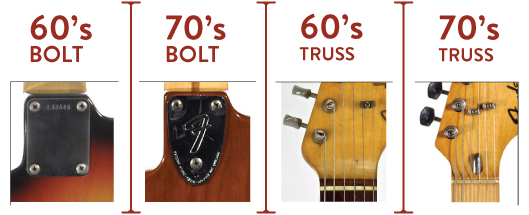Are you ready to dive into the story of what's often considered the most iconic and most widely played guitar ever?
In this post, we'll go from the beginning when Leo Fender launched the model in 1954 to the transitional Smith era of the early '80s. There are tons of other changes that the Fender Stratocaster experienced throughout this era, but this will give you a good overview with some high-res images to boot.

1954 Stratocaster Sunburst
A number of Stratocaster prototypes were built in 1954 with widely varying specs. Full production officially began in October when the final design was nailed down. In addition to a new highly contoured body shape, Fender launched the Strat with an innovative tremolo system and "two-tone" sunburst finish. The earliest era Strats used a wide D-shaped neck profile and a heavier Ash body.

1958 Stratocaster Sunburst
From 1954 to 1958 some key changes had occurred. As of mid-'56, Alder was the main body wood used, though rarer blonde Strats still used Ash. Components such as the string trees, tremolo system, and knobs continued to evolve, while the neck profile changed to more of a V-shape.
In 1958, the sunburst finish switched from "two-tone" to "three-tone" with striking red hues added along with the black and yellow. The other major change was a shift from a thicker V-shaped neck profile to a thinner D profile that would evolve as the year went on.

1959 Stratocaster Sunburst
About halfway through 1959, Fender introduced a "slab" rosewood fingerboard on most of its models (this lasted until 1962 when a thinner "veneer" style fretboard was introduced). 1959 also marked the shift from a single-ply white pickguard to a three-ply white-black-white celluloid nitrate pickguard. Over time, the composition of these pickguards lends a greenish tint which varies depending on exposure to light.

1964 Stratocaster Fiesta Red
Fender was purchased by CBS at the close of 1964 which marks the end of the classic or "Pre-CBS" era of Fender quality. In some cases, the CBS-era drift towards more mass production techniques already started to appear in late 1964 including a new headstock logo and a switch from clay to pearloid inlay dots.

1965 Stratocaster Olympic White
For Fender aficionados, 1964, 1965 and 1966 are considered the "transition era" and 1965 stands as the biggest turning point for Fender and Stratocaster production. Key indicators for Stratocasters of this period are a larger headstock compared to previous years as well as a script 'F' on the neck plate. In 1965, Fender also brought back the Maple fingerboard as an option.

The headstock shape and Fender logos changed throughout the CBS-era. The tuning machines changed from Kluson Deluxe to F-style in 1968.

1969 Stratocaster Lake Placid Blue
Throughout the late '60s, Fender quality under CBS continued to decline. As early as 1968, Fender began using a thicker polyurethane finish instead of the traditional nitrocellulose. Starting in 1969, Fender offered a single-piece Maple neck with the original "skunk stripe" as opposed to the glued-on Maple fretboard."

1974 Stratocaster Natural
Quality continued to decline in the '70s, and characteristic elements from this era include a three-bolt neck plate and a "bullet" truss rod adjustment system which were both introduced in 1971. Additionally, the overall contouring of the body shape gets less and less dramatic as time goes on.

Changes in the '70s included a 3-bolt neckplate and new 'bullet' style truss rod adjustment system at the top of the neck.

1976 Stratocaster Mocha
The Strat stayed largely the same in the late '70s though a black pickguard was introduced and eventually made standard on most finishes. In 1977, Fender started to include a five-way pickup selector which players had been implementing on their own for years by modifying the factory three-way selector.

1983 Stratocaster Sunburst "Smith Strat"
Like the CBS-transition of 1965, the early '80s brought a shift in management to Fender that directly impacted the guitars coming off the line. Fender marketing direct Dan Smith spear-headed an effort to bring the Strat back to historic standards with a smaller headstock and 4-bolt neck plate in the style of a pre-CBS era. This guitar also included a modern X-1 pickup in the bridge position.

1983 Stratocaster Sunburst
At the end of the resurgent "Dan Smith" era, Fender introduced a new Stratocaster with only two control knobs and a input jack mounted on the top of the body for 1983 and 1984. This cost-cutting model was referred to as the "Standard Stratocaster" (not to be confused with the later Made in Mexico Strat of the same name).
